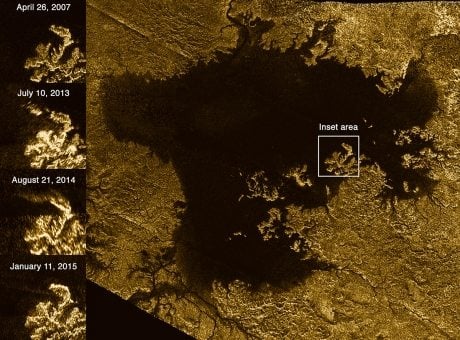In the shadow of Saturn’s hulking planetary mass, Titan’s liquid hydrocarbon seas seem a bit choppy, astronomers say.
Two and a half years ago, surfing through Cassini mission radar images of Ligeia Mare, the second-largest sea on Saturn’s moon Titan, a team of Cornell astronomers found a bright, mysterious feature – a transient feature they dubbed “Magic Island.”
Now, after Cassini observations in August 2014 and January 2015, the scientists confirm that Magic Island is, indeed, a transient feature, and the most likely culprit is surface waves, they report in the journal Icarus, Feb. 18.
“It’s really exciting, as we’ve confirmed that Titan’s seas are active environments,” said Jason Hofgartner, Ph.D. ’16, a NASA postdoctoral researcher at the Jet Propulsion Laboratory and the paper’s lead author. “There are stable liquids on the surface of Titan, and processes acting on these liquids are similar to those on Earth. Titan’s seas – though composed of liquid methane and ethane – are not stagnant but rather dynamic environments.”
The astronomers conclude these transient features may be floating or suspended solids, or bubbles, but most likely are waves.
During the August 2014 Cassini flyby, the Magic Island region of Ligeia Mare once again appeared anomalously bright compared with adjacent regions. Several months later in January 2015, Cassini flew by and detected no transient bright features.
The bitterly cold (290 degrees below zero) Titan features a thick atmosphere and is pocked with lakes, seas, rivers and islands, chiseled by liquid methane and ethane. It looks similar to Earth but with an orange haze.
Composed of liquid methane and ethane, Ligeia Mare is bigger than the Great Lakes’ Lake Superior. Cassini first observed the area in February 2007, and the mission’s last flyby images of Ligeia Mare will be acquired in April 2017.
On the paper, “Titan’s ‘Magic Islands’: Transient Features in a Hydrocarbon Sea,” Cornell authors include: Hofgartner; Alex Hayes, assistant professor of astronomy; Jonathan Lunine, the David C. Duncan Professor in the Physical Sciences; and Marco Mastrogiuseppe, research associate in astronomy. Research funding was provided by the National Suborbital Education and Research Center and NASA.


